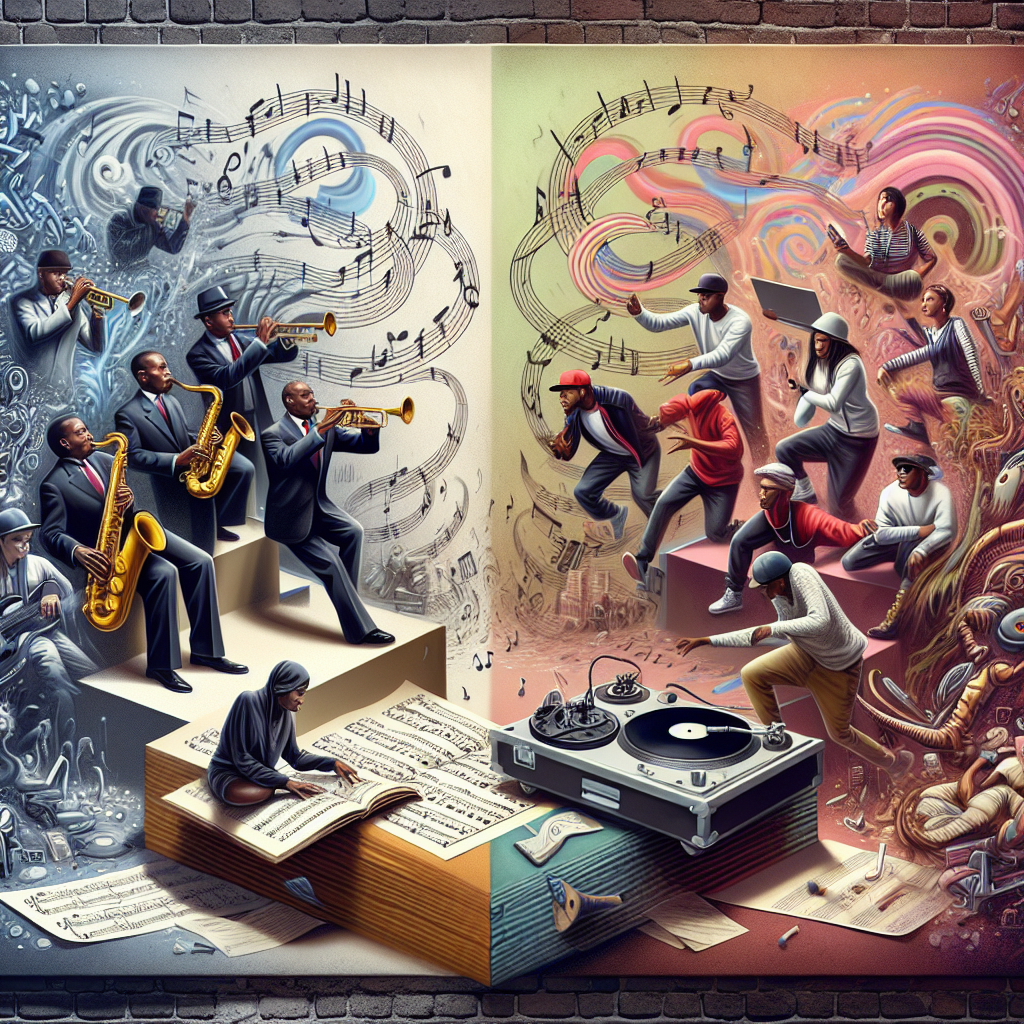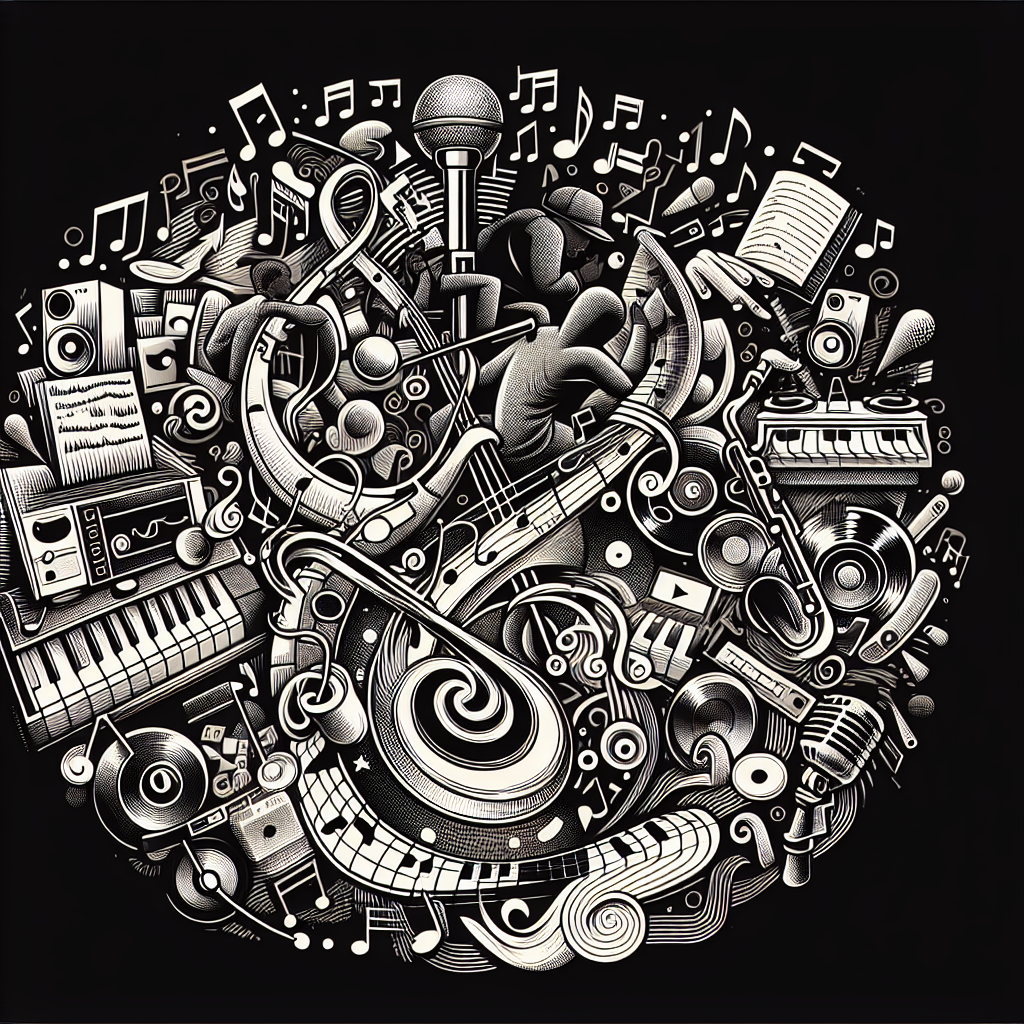“From Bebop to Beat Drops: Tracing Jazz’s Influence on Hip-Hop Production”
Introduction
Jazz has played a pivotal role in shaping the sound and cultural depth of hip-hop music. Since the emergence of hip-hop in the 1970s, jazz has infused this genre with complex rhythms, sophisticated musical samples, and a rich heritage of African American musical traditions. The integration of jazz into hip-hop production has not only expanded the sonic palette of the genre but has also contributed to its lyrical complexity and thematic diversity. This cross-genre pollination has led to the creation of a unique, innovative sound that resonates with a wide audience, influencing countless artists and shaping the direction of modern music.
Evolution of Sampling: From Jazz Records to Hip-Hop Beats
Jazz and hip-hop may seem like musical genres worlds apart, but the reality is that jazz has had a profound and enduring impact on hip-hop production. This relationship has not only enriched the musical landscape but has also fostered a unique cultural synthesis, illustrating how music evolves and adapts over time.
The roots of this influence trace back to the early days of hip-hop, born in the 1970s in the Bronx, New York. Here, pioneering DJs and producers discovered that jazz records, with their complex rhythms and soulful melodies, provided a rich source for the breakbeats needed in their own compositions. Jazz, with its emphasis on improvisation and expressive freedom, offered a treasure trove of sounds and styles that hip-hop artists could sample and recontextualize within their music.
Sampling, the technique of digitally encoding music or sound and reusing it as part of a composition or recording, became a cornerstone of hip-hop production. It allowed producers to stitch together snippets from various sources, creating a tapestry of sound that was both nostalgic and refreshingly new. Jazz records, often characterized by intricate instrumental solos and dynamic drum breaks, became a favorite for sampling because they added depth and complexity to hip-hop tracks.
As hip-hop evolved, so did the art of sampling. Producers like Madlib and J Dilla pushed the boundaries of this practice, turning sampling into an art form in itself. They dug deep into jazz archives, using obscure tracks and hidden gems rather than just popular hits. This not only highlighted their technical skills but also their deep respect and understanding of jazz as a genre. By manipulating these samples, they were able to create a new context for old sounds, giving them a modern twist while maintaining the emotional and rhythmic integrity of the original recordings.
Moreover, the use of jazz samples in hip-hop did more than just enhance its musical complexity; it bridged generational and cultural gaps. Older audiences, who might not have connected with hip-hop’s more contemporary expressions, found a familiar comfort in the jazz-infused tracks. Meanwhile, younger listeners were introduced to jazz through hip-hop, sparking a renewed interest in an older genre that might otherwise have seemed inaccessible.
This fusion of jazz and hip-hop has also led to collaborative works between artists from both genres, further enriching the musical dialogue. For instance, albums like Guru’s “Jazzmatazz” series paved the way for future collaborations by featuring both jazz musicians and hip-hop artists, creating blends that were seamless and symbiotic. These projects not only showcased the versatility of jazz musicians and hip-hop producers but also demonstrated the potential for cross-genre innovation.
Today, the impact of jazz on hip-hop is evident not just in the beats, but in the overall aesthetic and approach to music production. The improvisational nature of jazz has inspired hip-hop producers to experiment and innovate, ensuring that the genre continues to evolve and resonate with audiences worldwide. This ongoing relationship between jazz and hip-hop is a testament to the power of music to transcend boundaries, fostering a creative exchange that enriches both genres.
In conclusion, the journey from jazz records to hip-hop beats is not just a tale of musical evolution but a narrative of cultural fusion. It highlights how music can be a universal language, capable of bridging diverse musical expressions and traditions, creating something entirely new and profoundly impactful.
Influence of Jazz Improvisation on Hip-Hop’s Lyrical Flow

Jazz and hip-hop may seem like genres worlds apart, but the reality is that jazz has had a profound impact on the evolution of hip-hop production, particularly in how it has shaped the genre’s unique lyrical flow. This relationship between jazz and hip-hop is not just a passing phase but a deep-rooted connection that continues to influence emerging artists and producers.
The improvisational nature of jazz, characterized by its spontaneous and dynamic creation of melody, has been a significant influence on hip-hop. Jazz musicians like Miles Davis and John Coltrane were masters of improvisation, weaving complex solos that ventured off the written music into uncharted territories. This aspect of jazz has inspired hip-hop artists to adopt a similar approach in their lyrical delivery—valuing spontaneous, on-the-spot creativity that makes each performance unique.
In hip-hop, this improvisational influence manifests as freestyling, where artists deliver lyrics without prior preparation, often in a battle or live performance setting. This method not only tests the rapper’s lyrical skills but also their ability to stay rhythmically and thematically coherent, much like a jazz soloist maintaining the flow within a jazz band’s dynamic. The ability to think and respond quickly, which is central to jazz, is equally valued in the hip-hop arena, where MCs are revered for their quick wit and responsiveness.
Moreover, the sample-based nature of hip-hop production has borrowed heavily from jazz. Producers like Madlib and J Dilla are known for their extensive use of jazz samples, incorporating these into their beats to create a rich, layered sound that carries the emotional and improvisational feel of jazz. Sampling is not just about lifting a snippet of melody or rhythm; it’s about capturing the essence of a jazz piece—the mood, the atmosphere, and the spirit—and reimagining it in a hip-hop context. This process mirrors the jazz approach of theme and variation, where the core theme is explored in new and inventive ways.
The syncopated rhythms and complex chord progressions typical in jazz have also found their way into hip-hop music, challenging artists to push the boundaries of their lyrical rhythm and flow. A jazz-influenced beat might feature off-beat rhythms and unusual time signatures, providing a rich sonic canvas for rappers to experiment with different flows. This complexity not only enhances the musicality of hip-hop but also enriches the lyrical content, as artists find innovative ways to align their words with the intricate beats.
The emotional depth of jazz, with its expressive solos and deep emotional undertones, has encouraged hip-hop artists to delve deeper into their own stories, crafting lyrics that are not only rhythmically engaging but also profoundly personal and reflective. This emotional connection is vital, as it bridges the listener’s experience with the artist’s intent, creating a more immersive and impactful experience.
In conclusion, the influence of jazz on hip-hop is a testament to the power of musical innovation and cross-genre inspiration. Jazz’s improvisational nature has not only influenced the technical aspects of hip-hop production and lyrical flow but has also imbued it with a spirit of creativity and emotional depth that continues to resonate with audiences. As hip-hop continues to evolve, the echoes of jazz will undoubtedly continue to shape its path, proving that music, in all its forms, is a universal language of creativity and expression.
Pioneering Jazz Musicians and Their Legacy in Hip-Hop Production
Jazz and hip-hop may seem like genres worlds apart, but the rhythmic roots and expressive beats of jazz have significantly sculpted the landscape of hip-hop production. This profound influence traces back to the pioneering jazz musicians whose legacies continue to resonate within the beats and bars of contemporary hip-hop.
The story begins with the likes of Miles Davis and John Coltrane, whose innovative approaches to music laid down the foundational ethos for experimentation and expression in music. Davis, known for his cool jazz rhythms and modal music explorations, introduced a level of improvisation that has become a staple in hip-hop music production today. His album “Kind of Blue” is a testament to the power of modal jazz, which has inspired hip-hop producers to experiment with form and structure, leading to some of the genre’s most groundbreaking tracks.
Similarly, John Coltrane’s complex rhythmic patterns and phrasing in pieces like “Giant Steps” have challenged and inspired hip-hop producers to incorporate intricate beats and samples in their tracks. The saxophonist’s relentless pursuit of innovation and his ability to push musical boundaries resonate deeply within hip-hop, a genre that thrives on new sounds and the reimagining of old ones.
Transitioning from these monumental figures, the role of jazz in hip-hop became even more pronounced with artists who directly bridged the gap between the two genres. Herbie Hancock, for instance, not only influenced hip-hop with his jazz-funk fusion albums but also actively participated in the early hip-hop scene. His 1983 hit “Rockit” is notable for its pioneering use of turntable scratching, proving that the integration of jazz and hip-hop could produce chart-topping hits.
Moreover, the sampling of jazz records has been a fundamental element in hip-hop production, allowing producers to tap into a rich vein of complex melodies, harmonies, and rhythms. A Tribe Called Quest, a group known for their intelligent lyricism and innovative beats, frequently used jazz samples to create a lush, layered sound that set them apart from their contemporaries. Their track “Jazz (We’ve Got)” is essentially an homage to the genre, showcasing samples from several jazz classics woven seamlessly with hip-hop rhythms.
The influence of jazz on hip-hop is not just limited to samples and beats; it extends to the very essence of musical freedom and creativity that defines both genres. Jazz musicians’ emphasis on improvisation and personal expression has encouraged hip-hop artists to view their music as a canvas for innovation, not just a vessel for vocals. This has led to richer, more complex productions that challenge the listener’s perceptions and expectations.
As hip-hop continues to evolve, the legacy of jazz within it remains a vital force. Newer artists and producers, drawing on the vast sonic landscapes created by their predecessors, are pushing the boundaries even further. This ongoing dialogue between jazz and hip-hop not only enriches both genres but also ensures that the music remains a dynamic and evolving form of cultural expression.
In conclusion, the impact of jazz on hip-hop production is a testament to the enduring power of musical innovation. The pioneering jazz musicians, with their groundbreaking techniques and fearless explorations, have left an indelible mark on hip-hop. Their legacy is carried forward by hip-hop artists and producers who continue to draw inspiration from jazz, ensuring that the music remains as vibrant and vital as ever.




